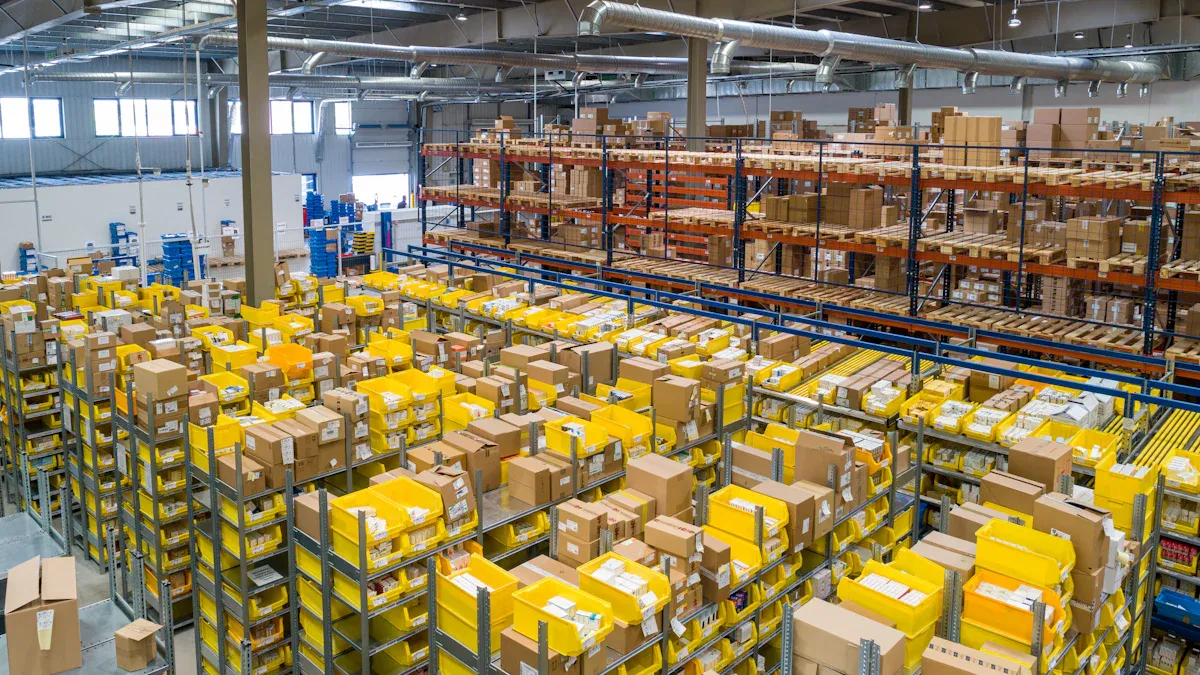How to Spot Warehouse Management Inefficiencies On-Site

Warehouse management inefficiencies often go unnoticed until they disrupt operations. Their effects ripple through the supply chain, leading to higher costs, reduced productivity, and dissatisfied customers. For instance, companies with accuracy rates below 95% may face operational costs up to 15% higher than those achieving 99%. Similarly, an on-time delivery rate below 92% can erode trust and loyalty. JUSDA’s supply chain solutions offer tailored strategies to tackle these challenges, ensuring optimized processes and measurable improvements across key performance metrics.
Key Takeaways
Look for mistakes in orders and late deliveries. Train workers better and talk clearly to make customers happy.
Watch for missing inventory carefully. Use strong tracking tools and check often to avoid losses and keep profits up.
Arrange the warehouse better to use space wisely. Check and change storage often to make work easier and less messy.
Check why costs are going up to find problems. Study the issues and fix them with smart solutions.
Use technology like smart devices and data tools to track in real-time. These tools help improve work and make better choices.
Common Signs of Warehouse Management Inefficiencies
Frequent order errors and delays
Order errors and delays are among the most visible signs of warehouse management inefficiencies. Mistakes in order fulfillment, such as picking incorrect items or mislabeling shipments, disrupt operations and increase costs. These errors often lead to delayed deliveries, frustrating customers and damaging trust. For example, a warehouse with 99% accuracy may still produce six errors in a 300-line-item order, while a 3000-item order could result in 60 errors. Such discrepancies can escalate operational costs and negatively impact customer satisfaction.
Timely and accurate order processing is essential for maintaining efficiency. When errors occur, they often stem from inadequate training, outdated systems, or poor communication between departments. These issues can create bottlenecks, delaying shipments and causing out-of-stock situations. Nearly 78% of customers abandon deals due to poor experiences, highlighting the importance of optimizing order management processes. Warehouses must prioritize error reduction to improve customer relationships and operational performance.
High levels of inventory shrinkage
Inventory shrinkage refers to the loss of stock due to theft, damage, or mismanagement. While the average shrinkage rate in warehouses is 0.2%, rates exceeding 0.46% are considered alarming. Historically, warehouses experienced shrinkage rates as high as 4%, but improved processes have reduced this figure to 2%. However, even small percentages can lead to significant financial losses. For instance, a warehouse with $1 million in inventory but only $950,000 accounted for after a count would face a shrinkage rate of 5%.
Poor tracking systems and lack of accountability often contribute to inventory shrinkage. Misplaced items, unrecorded transactions, and insufficient security measures increase the risk of loss. Shrinkage not only affects profitability but also disrupts inventory planning, leading to stockouts or overstocking. Warehouses must implement robust tracking systems and regular audits to minimize shrinkage and maintain operational efficiency.
Poor space utilization and cluttered layouts
Disorganized warehouse layouts and inefficient storage systems hinder productivity. Employees waste valuable time searching for misplaced items, reducing morale and overall efficiency. Cluttered environments also pose safety hazards and increase overhead costs, as businesses may need additional space to accommodate poorly organized inventory.
Effective space utilization is critical for optimizing warehouse operations. Poor layouts often result from inadequate planning or outdated storage systems. By reorganizing inventory and implementing modern storage solutions, warehouses can reduce clutter and improve workflow. Employees can locate items faster, enhancing productivity and ensuring smoother operations.
Tip: Regularly assess warehouse layouts and invest in space-saving technologies to maximize efficiency and reduce unnecessary costs.
Rising operational costs without clear justification
Rising operational costs often signal underlying inefficiencies in warehouse management. These costs can stem from various factors, including excessive labor expenses, energy wastage, and outdated equipment. Identifying the root causes of these increases is essential for maintaining profitability and operational efficiency.
One common contributor to rising costs is overstaffing or inefficient labor allocation. Warehouses that lack proper workforce planning may assign too many employees to tasks that require fewer resources. For instance, assigning multiple workers to a single picking operation when automation could handle the task more efficiently leads to unnecessary expenses. Regularly analyzing labor productivity and implementing workforce optimization strategies can help address this issue.
Energy consumption also plays a significant role in operational costs. Poorly maintained equipment, inadequate lighting systems, and inefficient heating or cooling solutions can drive up utility bills. For example, a warehouse with outdated HVAC systems may consume 30% more energy than one with modern, energy-efficient alternatives. Conducting energy audits and investing in sustainable technologies can significantly reduce these expenses.
Another factor is the use of outdated or poorly maintained equipment. Forklifts, conveyor belts, and other machinery that frequently break down not only disrupt operations but also incur high repair costs. Preventive maintenance programs and timely equipment upgrades can minimize these disruptions and lower long-term expenses.
Additionally, poor inventory management can lead to hidden costs. Overstocking ties up capital and increases storage expenses, while understocking results in missed sales opportunities. Implementing advanced inventory tracking systems, such as JUSDA’s JusLink platform, provides real-time visibility and helps optimize stock levels. This reduces waste and ensures that resources are allocated efficiently.
Warehouses experiencing rising costs without clear justification should conduct a comprehensive assessment of their operations. By identifying inefficiencies and implementing targeted solutions, businesses can regain control over their expenses. Addressing these challenges not only improves financial performance but also enhances overall productivity.
Tip: Regularly monitor operational expenses and compare them against industry benchmarks to identify potential inefficiencies early.
Tools and Technologies to Identify Warehouse Management Inefficiencies

Internet of Things (IoT) for real-time tracking
The Internet of Things (IoT) has revolutionized warehouse operations by providing real-time tracking capabilities. IoT devices, such as sensors, RFID tags, and GPS trackers, offer unmatched visibility into the location and condition of goods. Logistics managers can monitor shipments closely, identify delays, and make quick decisions to address issues. This level of visibility improves planning and allows for better route optimization and resource allocation. For example, IoT-enabled sensors can track temperature-sensitive items, ensuring they remain within safe conditions during transit. By leveraging IoT, warehouses can enhance efficiency and reduce the risks associated with mismanagement.
Predictive analytics for operational insights
Predictive analytics uses data to forecast future trends and identify areas for improvement. Warehouses can analyze historical data to optimize inventory levels, streamline order fulfillment, and minimize waste. For instance, predictive models can anticipate demand spikes, enabling managers to adjust stock levels proactively. This reduces the risk of overstocking or stockouts. Studies show that predictive analytics significantly increases operational efficiency by identifying bottlenecks and improving decision-making. Warehouses that adopt this technology can stay ahead of potential challenges and maintain smooth operations.
Barcode and RFID scanning systems
Barcode and RFID scanning systems simplify inventory tracking and reduce errors in warehouse management. Barcodes provide a cost-effective way to label and track items, while RFID technology offers faster and more accurate scanning. Employees can use handheld scanners to update inventory records instantly, ensuring real-time accuracy. RFID systems, in particular, allow for bulk scanning, saving time during large-scale operations. These technologies improve inventory visibility and reduce manual errors, making them essential tools for modern warehouses. By implementing barcode and RFID systems, businesses can enhance productivity and maintain better control over their inventory.
Processes for Regular Assessments in Warehouses
Conducting regular cycle counts
Cycle counts are essential for maintaining inventory accuracy. Unlike full physical inventory counts, cycle counts focus on smaller, manageable sections of inventory. This method allows warehouses to identify discrepancies without disrupting daily operations. For example, a warehouse might schedule weekly counts for high-turnover items and monthly counts for slower-moving stock.
Cycle counts help uncover errors caused by mislabeling, misplaced items, or system inaccuracies. By addressing these issues promptly, warehouses can reduce stockouts and overstocking. Implementing a structured cycle count schedule ensures consistent monitoring and improves overall inventory reliability.
Tip: Use advanced inventory management systems, such as JUSDA’s JusLink, to automate cycle count scheduling and track results in real time.
Performing root cause analysis for recurring issues
Recurring issues often signal deeper inefficiencies in warehouse operations. Root cause analysis (RCA) helps identify the underlying problems rather than just addressing symptoms. For instance, frequent picking errors might stem from poor employee training or unclear labeling systems.
Warehouses can use tools like fishbone diagrams or the “5 Whys” technique to trace problems back to their source. Once identified, managers can implement targeted solutions, such as revising workflows or upgrading equipment. RCA not only resolves current issues but also prevents them from recurring, leading to long-term operational improvements.
Note: Documenting RCA findings and corrective actions ensures accountability and provides a reference for future problem-solving efforts.
Monitoring key performance indicators (KPIs)
KPIs provide measurable insights into warehouse performance. Metrics such as order accuracy, inventory turnover, and on-time shipments highlight areas that need improvement. For example, a low inventory turnover rate might indicate overstocking or slow-moving products.
Regularly reviewing KPIs allows managers to track progress and adjust strategies as needed. Advanced platforms like JusLink simplify KPI monitoring by consolidating data into customizable dashboards. This enables managers to make data-driven decisions and address inefficiencies proactively.
Did you know? Warehouses that monitor KPIs consistently achieve up to 20% higher operational efficiency compared to those that don’t.
By integrating these processes, warehouses can identify and address inefficiencies effectively. Regular assessments ensure smoother operations and contribute to long-term success.
Scheduling periodic on-site audits
Periodic on-site audits play a crucial role in identifying inefficiencies within warehouse operations. These audits provide a structured approach to evaluate processes, equipment, and overall performance. By conducting regular inspections, managers can uncover hidden issues that may not be apparent during daily operations.
A well-planned audit should focus on key areas such as inventory accuracy, equipment functionality, and workflow efficiency. For example, an audit might reveal that outdated equipment causes frequent delays in order processing. Addressing such issues promptly can prevent further disruptions and improve productivity.
Tip: Use a checklist during audits to ensure no critical area is overlooked. Include categories like safety compliance, inventory management, and employee performance.
Audits also help in benchmarking performance against industry standards. Comparing metrics such as order accuracy and inventory turnover with competitors provides valuable insights. This data enables managers to set realistic goals and track progress over time.
Scheduling audits at regular intervals ensures consistency. Quarterly or biannual audits work well for most warehouses, but high-volume facilities may benefit from monthly reviews. Managers should document findings and create action plans to address identified inefficiencies. Sharing these plans with the team fosters accountability and encourages continuous improvement.
Gathering employee feedback to identify bottlenecks
Employees working on the warehouse floor often have firsthand knowledge of operational challenges. Gathering their feedback provides valuable insights into bottlenecks and inefficiencies. Workers may notice recurring issues, such as delays in receiving shipments or difficulties locating items, that managers might overlook.
Encouraging open communication is essential. Managers can use anonymous surveys, suggestion boxes, or one-on-one meetings to collect honest feedback. For instance, a survey might reveal that employees struggle with outdated inventory systems, leading to frequent errors.
Did you know? Warehouses that actively seek employee input report a 25% improvement in operational efficiency.
Analyzing feedback helps managers identify patterns and prioritize solutions. For example, if multiple employees highlight slow picking processes, investing in automation or reorganizing layouts could resolve the issue. Recognizing and addressing employee concerns also boosts morale and fosters a collaborative work environment.
Regularly reviewing feedback ensures that warehouses adapt to changing needs. By involving employees in problem-solving, managers can create a culture of continuous improvement and operational excellence.
Actionable Strategies to Address Warehouse Management Inefficiencies

Optimizing warehouse layouts with JUSDA's tailored solutions
An optimized warehouse layout improves efficiency and reduces operational bottlenecks. JUSDA offers tailored solutions that address specific challenges in warehouse design. These solutions focus on maximizing space utilization, streamlining workflows, and enhancing accessibility.
JUSDA begins by analyzing the current layout and identifying inefficiencies. For example, cluttered aisles or poorly organized storage zones often slow down operations. By reorganizing inventory based on demand frequency, warehouses can reduce the time employees spend locating items. High-demand products should be stored closer to picking and packing areas, while low-demand items can occupy less accessible spaces.
JUSDA also incorporates advanced technologies like automated storage and retrieval systems (AS/RS). These systems optimize vertical space and improve inventory management. For instance, warehouses using AS/RS report up to 40% faster picking times. Additionally, JUSDA’s JusLink platform integrates seamlessly with these systems, providing real-time inventory visibility and improving decision-making.
Tip: Regularly review and adjust warehouse layouts to accommodate changes in inventory levels or product demand.
Implementing staff training programs for operational excellence
Well-trained employees are essential for efficient warehouse operations. Training programs enhance skills, reduce errors, and improve overall productivity. JUSDA emphasizes the importance of continuous learning to address Warehouse Management Inefficiencies effectively.
Training programs should cover key areas such as inventory management, equipment handling, and safety protocols. For example, employees trained in using barcode and RFID systems can process orders more accurately and quickly. JUSDA provides customized training modules tailored to the specific needs of each warehouse. These modules include hands-on sessions, ensuring employees gain practical experience.
Cross-training employees is another effective strategy. Workers trained in multiple roles can fill in during staff shortages, maintaining operational continuity. For instance, a picker trained in packing can step in during peak seasons, reducing delays.
Recognizing and rewarding employee performance also boosts morale and encourages excellence. Warehouses that implement incentive programs often see a 15% increase in productivity.
Did you know? Warehouses with comprehensive training programs report 30% fewer errors in order processing.
Standardizing processes and workflows
Standardized processes ensure consistency and reduce inefficiencies. JUSDA helps warehouses develop clear workflows that align with industry best practices. Standardization minimizes errors, improves communication, and enhances overall efficiency.
The first step involves documenting all existing processes. For example, warehouses should outline procedures for receiving, storing, picking, and shipping inventory. Clear documentation ensures that all employees follow the same steps, reducing variability.
JUSDA recommends using visual aids like flowcharts or checklists to simplify complex workflows. For instance, a checklist for order picking can help employees verify each step, reducing errors. Standard operating procedures (SOPs) should also include guidelines for handling exceptions, such as damaged goods or returns.
Automation plays a crucial role in standardization. Tools like JUSDA’s JusLink platform automate repetitive tasks, such as inventory updates or order tracking. Automation reduces manual errors and frees up employees for higher-value tasks.
Regularly reviewing and updating workflows ensures they remain relevant. For example, changes in product lines or customer demands may require adjustments to picking or packing processes. Continuous improvement keeps operations aligned with business goals.
Note: Standardized workflows improve scalability, making it easier for warehouses to handle increased volumes during peak seasons.
Leveraging automation for repetitive tasks
Automation has become a cornerstone of modern warehouse operations, offering solutions to repetitive tasks that often consume time and resources. By integrating automated systems, warehouses can streamline processes, reduce errors, and improve overall efficiency.
Implementing Automation to Address Inefficiencies
Warehouses experiencing inefficiencies, such as delays or high error rates, can benefit significantly from automation. For instance, facilities struggling with frequent order errors may implement robotic picking systems to enhance accuracy. Similarly, warehouses facing space constraints can adopt AS/RS to optimize storage layouts.
JUSDA’s JusLink platform complements automation by providing real-time visibility into warehouse operations. It integrates seamlessly with automated systems, offering actionable insights and predictive analytics. This combination enables managers to identify and address inefficiencies proactively.
Tip: Start small when implementing automation. Focus on one area, such as picking or sorting, and expand as the benefits become evident.
Automation not only addresses Warehouse Management Inefficiencies but also positions businesses for long-term success. By investing in advanced technologies, warehouses can improve operational performance, reduce costs, and enhance customer satisfaction.
Identifying and addressing warehouse management inefficiencies is crucial for maintaining smooth operations and reducing costs. These inefficiencies can disrupt workflows, increase expenses, and harm customer satisfaction. By recognizing these challenges early, businesses can take corrective actions to improve efficiency.
JUSDA's advanced warehouse solutions and technologies provide the tools needed to transform operations. From real-time tracking to predictive analytics, these innovations help businesses optimize workflows and enhance productivity. Managers should take proactive steps to implement these solutions and ensure long-term success.
FAQ
How often should warehouses conduct audits?
Warehouses should conduct audits quarterly or biannually to identify inefficiencies and ensure compliance. High-volume facilities may benefit from monthly reviews. Regular audits help managers uncover hidden issues and maintain operational efficiency.
What is the role of employee feedback in improving warehouse efficiency?
Employee feedback highlights operational bottlenecks and recurring issues. Workers on the floor often notice inefficiencies that managers might overlook. Gathering input through surveys or meetings fosters collaboration and helps prioritize solutions.
How does JUSDA support warehouse optimization?
JUSDA provides tailored solutions like JusLink for real-time tracking and predictive analytics. Its advanced technologies and training programs help warehouses improve layouts, reduce errors, and enhance overall efficiency.
See Also
Harnessing Robotics To Boost Warehouse Efficiency And Output
Understanding Robotic Automation For Improved Warehouse Efficiency
Discover JUSDA's Innovative Warehousing Solutions For Greater Efficiency
